Cover Gallery: Gone Fishin’
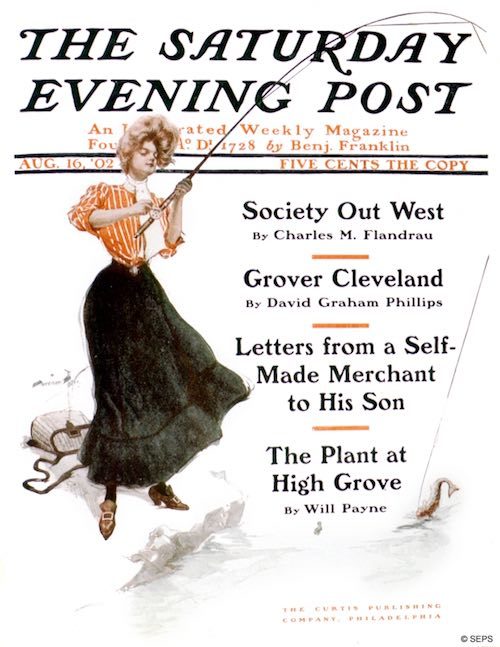
Harrison Fisher
August 16, 1902
Harrison Fisher (1877 –1934) was an American illustrator. Both his father and his grandfather were artists. As you might be able to tell from this cover, Fisher was considered a successor to Charles Dana Gibson, famous for his Gibson Girls.
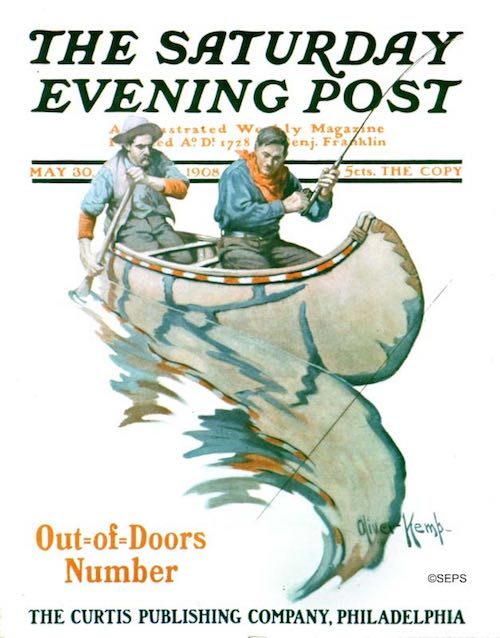
Oliver Kemp
May 30, 1908
Oliver Kemp (1887-1934) painted 11 covers for the Post. He made yearly trips to the Rocky Mountains and was fond of painting scenes of western America. His Post covers all depicted rugged men hunting, fishing, and canoeing, often with a pipe between their teeth.
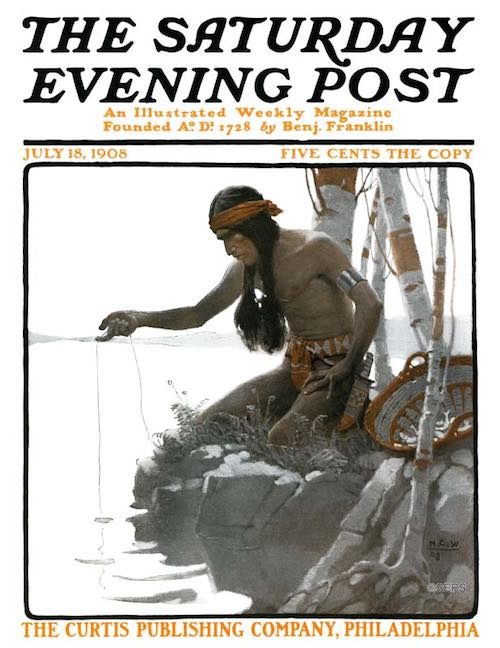
N.C. Wyeth
July 18, 1908
Newell Convers Wyeth (1882 –1945), was probably best known for his illustrations of Scribner’s classics, particularly Treasure Island. He spent part of his twenties out West, learning about cowboy and Native American culture. Wyeth painted his first cover for the Post when he was only 20; he was 25 when he completed “Indian Fishing.” N.C. Wyeth is the father of painter Andrew Wyeth.
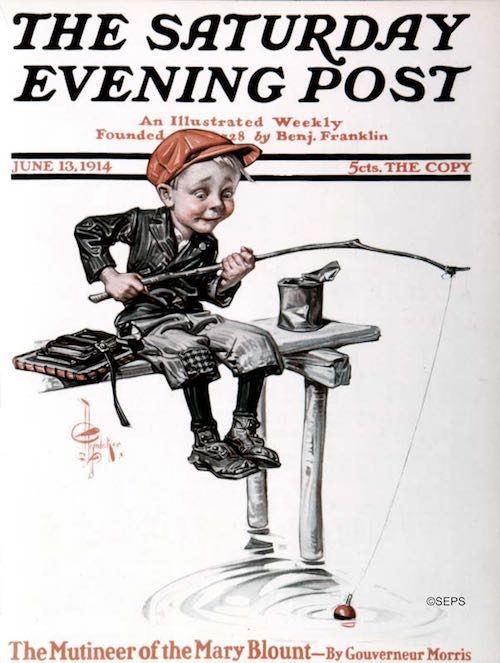
J.C. Leyendecker
June 13, 1914
J.C. Leyendecker was the most prolific cover illustrator for the Post, painting 323 covers. (Rockwell stopped at 322 out of respect for Leyendecker.) It was Leyendecker who popularized the images of a fat, jolly Santa and the New Year’s baby. While Leyendecker’s depictions of men were usually handsome and strapping, many of his children appeared emaciated and sickly, and often had bodies that were disproportionately smaller than their heads.
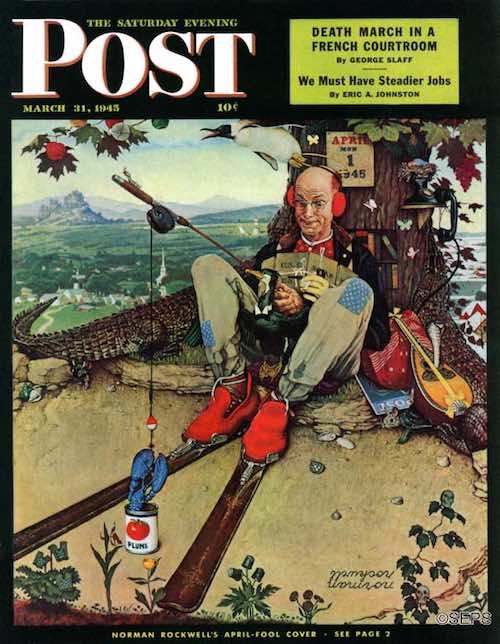
Norman Rockwell
March 31, 1945
[From the editors of the March 31, 1945 issue] Probably no Post cover has ever been more popular than Norman Rockwell’s first April Fool cover. In this week’s cover, Mr. Rockwell is trying to fool you again, and he probably will succeed. Watch out for the blue lobster. As a matter of fact, we don’t think this one is quite fair, and we’re going to tell you that there is such a thing as a blue lobster. According to Charles Mohr, of the Academy of Natural Sciences in Philadelphia, the blue lobster is a rarity, but every once in a while one of them turns up in Maine waters, and it is completely blue. John Atherton, whose covers are well known to Post readers and who is a neighbor of Mr. Rockwell’s in Arlington, Vermont, once made a peculiar face while he was talking to Mr. Rockwell, and Norman remembered it and used Mr. Atherton with this particular expression as a model for this cover. There are at least fifty mistakes. See how many you can find and compare your findings with those listed on page 80.

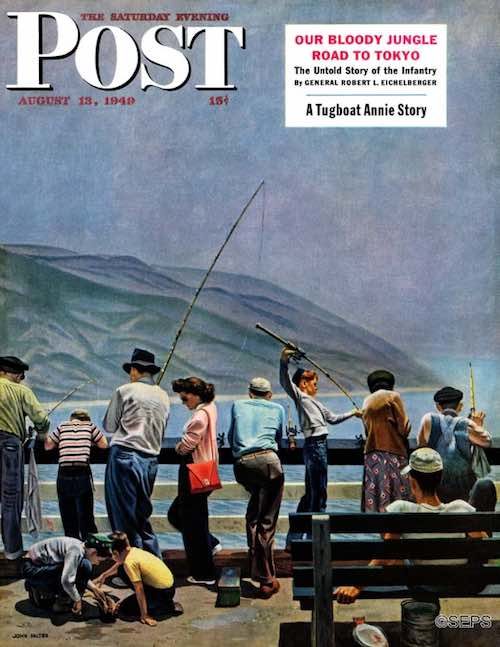
John Falter
August 13, 1949
[From the editors of the March 31, 1949 issue] On the long fishing pier at Santa Monica, California, tourists from all over the United States stand packed together like sardines while they try to catch fish. They are so grimly intent on their work or play or whatever it is that when a baited minnow smacks the water in all that silence, it makes quite a startling splash. Many of the fishermen go through their routine calmly and expertly; occasionally a greenhorn flies into a tizzy, yelps for the landing net and hauls in a dwarf flounder or something else depressing. The kids have a swell time fussing with starfish or reading a wet comic page which was wrapped around a wad of bait. Artist John Falter was non-committal about whether he caught anything—besides a Post cover.
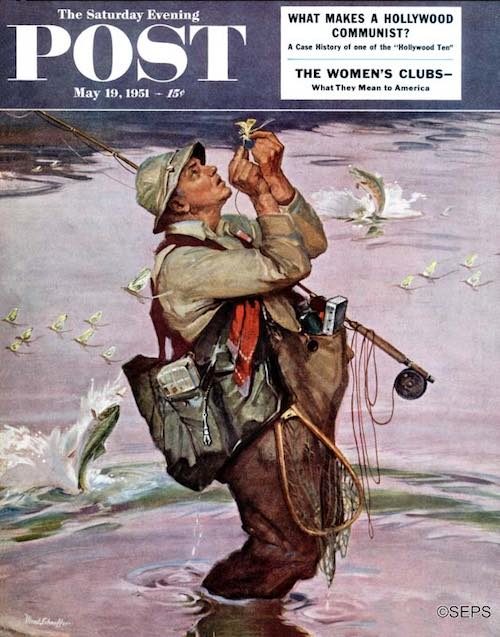
Mead Schaeffer
May 19, 1951
[From the editors of the May 19, 1951 issue] Those flies driving the man and the fish crazy are a variety known to fishermen as Green Drake. We don’t know what the fish call them. Just before this picture was painted, the man was calmly trying to feed the trout another variety of fly and they were calmly ignoring his hospitality. Suddenly, a countless family of Green Drake “nymphs,” which previously had risen to the surface of the water to hatch, discovered that they had wings, and decided to zoom into the wild blue yonder. Mead Schaeffer’s angler is trying to affix an artificial Green Drake to his line before the trout are so full of real Drakes that they sink to the bottom for a nap. Fishermen who experience such crises say that the general confusion is hard to imagine.
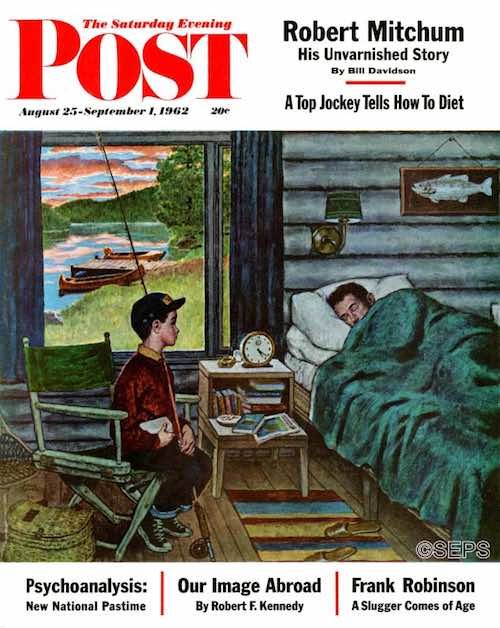
August 25, 1962
Amos Sewell
[From the editors of the August 25, 1962 issue] Forty more minutes to go, broods Amos Sewell’s thwarted young angler, and then Dad will waste still more time washing up and eating and dawdling over his coffee. From the look of this somnolent scene, it is clear that no fish will be disturbed until at least seven o’clock, and then, as any youngster knows, the fish will be settling for a siesta. Why, wonders the young sprat, can’t fathers coordinate their sleeping habits with those of fish?
Rockwell in the 1950s – Part III of III
“The Soda Jerk” – August 22, 1953
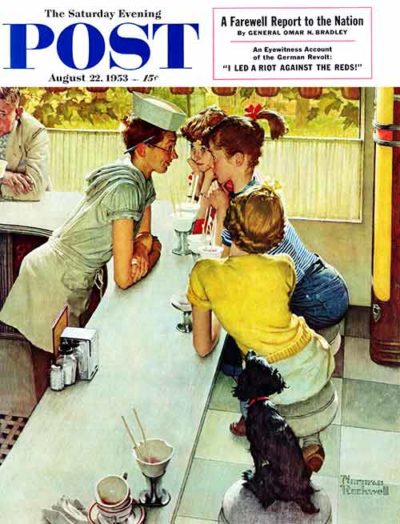
“The Soda Jerk”
From August 22, 1953
Perhaps it’s the prestigious position of being a soda jerk, but these young ladies are clearly not just there for the ice cream. Rockwell’s three sons often posed for his paintings, and this babe magnet is Peter, his youngest. In fact, the artist got the idea for this cover while listening to Peter talk about his summer job at a soda fountain.
Tthere is Rockwell’s attention to detail: the non-slip wooden floor behind the counter, the dishes that should have been cleared, even the reflection of the salt and sugar containers in the chrome of the napkin holder. A chubby guy at the counter looks on enviously, thinking, “what does he have (besides ice cream) that I don’t have?”
Alas, every artist has his critics. Peter wasn’t thrilled with the result, saying, “I’m not that goofy-looking.”
“Happy Birthday, Miss Jones” – March 17, 1956
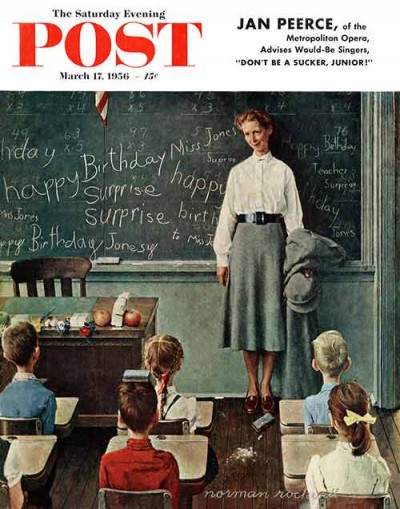
“Happy Birthday, Miss Jones”
From March 17, 1956
Anne Braman, from Rockwell’s hometown, posed for this tribute to the schoolteacher in a local classroom. First Rockwell posed the children (love the kid with the eraser on his head, as if he didn’t have time to “straighten up” from mischief before the teacher arrived) and then they were sent to another room where they were given a Coke and a check.
“Then Mr. Rockwell posed me against the blackboard,” Ms. Braman told the Post in 1976. “His late wife, Mary, was present and did not care for the shoes I was wearing at the time, and suggested I put on hers, which were at least two sizes too large for me.” Like other models we’ve reviewed from the 50s, the cover made Anne something of a celebrity. “When I attended my twenty-fifth high school reunion,” she told us, “I was given a prize for being the first member of the class to be a ‘cover girl.’”
But the cover below was Anne’s favorite, for a special reason.
“The Marriage License” – June 11, 1955
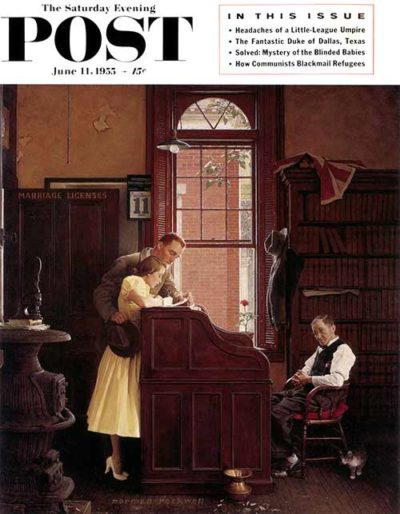
“The Marriage License”
From June 11, 1955
It is late afternoon on a Saturday (the calendar even gives us the day), and the elderly clerk has his boots on and would like to get home. Couples in love are a humdrum regularity in this office. By contrast, an excited young couple is happily filling out the paperwork for their marriage license, a momentous occasion they are not inclined to rush. This was a real engaged couple, Joan Lahart and Francis Mahoney, of nearby Lee, Massachusetts. Of the big, handsome groom-to-be, Rockwell said, “You know, this is a self-portrait of myself. At least that is what I would have liked to look like if I had had the opportunity.”
This famous 1955 cover meant a great deal to Anne Braman, who posed as the teacher above. Earlier that year, “my mother-in-law died. Mr. Rockwell, knowing my father-in-law, Jason C. Braman, realized how upset he was and he thought if he could get him to model it would give him something new to think about. Mr. Rockwell indicated he had done this sort of thing in the past when someone had lost a loved one.” Mr. Braman made a fine town clerk.
The famous Rockwell detail is there. You can almost touch the cold iron of the stove (it is June, after all). The artist was very specific about what the young lady would wear, and the bright sunshine yellow of her dress contrasts beautifully with all the dark wood. Add the magnificent lighting from the window, and this may be one of Rockwell’s best covers.
Dwight David Eisenhower – October 11, 1952
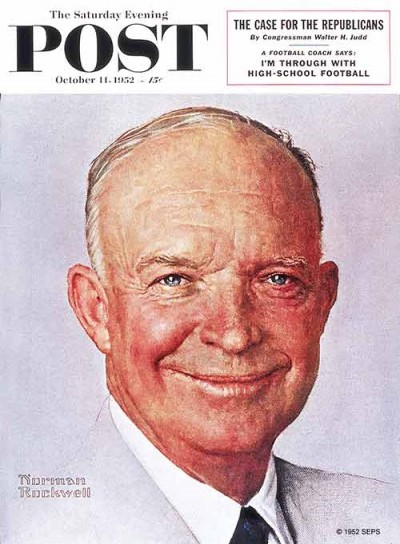
Dwight David Eisenhower
From October 11, 1952
Ike was excited to show Rockwell his paintings and get some expert advice. “They were terrible,” Rockwell said. “His stuff was not quite as good as Churchill’s, who was also an amateur artist, you know, but he was a wonderful man. I guess I liked painting him best of all the presidents. Yea, Ike was as comfortable as an old shoe. Maybe that’s why the two of us got along so well.” This was 1952, but four years later, Ike again appeared in a Rockwell cover, as did his opponent, Adlai Stevenson, whom the artist recalled as “amiable, kind, unpretentious, and quietly charming.” Kind of makes it hard to tell which side of the political fence the artist was on, but it is refreshing to hear that both politicians were amiable and unpretentious.
“Rockwell Meets the President” June 11, 1955
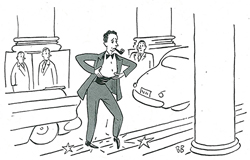
“Rockwell Meets the President”
From June 11, 1955
President Eisenhower invited the artist to a White House dinner in 1955. Post editors got word that the artist “was observed galumphing around his home town of Stockbridge, Massachusetts in a new set of shiny black evening shoes” in an attempt to break them in. It was also noted “Rockwell also bought a cummerbund to undergird his tux, and it almost broke in his stomach, but he stayed with it.” Since the editors enjoyed tweaking Rockwell, they ran this cartoon of a spiffy but uncomfortable Norman on his way to meet the President.
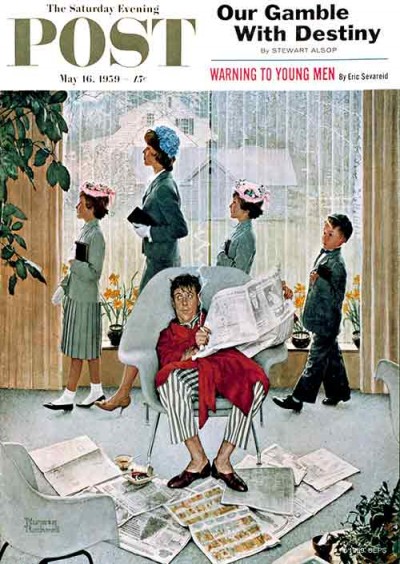
“Easter Morning”
From May, 16, 1959
“Why is papa not going to church—is he ill?” asked the editors of this 1959 cover. “No, his health is sound, except that he is suffering a momentary chill as his family coldly passes by.” Okay, dad really should go to church, but the lure of a comfy Sunday with coffee and the sports pages is stronger than the appeal getting dressed up for a crowded Easter Sunday.
Interestingly, the view outside the window is the exact view outside Rockwell’s studio. On the cutting edge was the sleek Scandinavian furniture—the artist scoured furniture stores for just the right chair. The wife is portrayed by Rockwell’s daughter-in-law, Gail. When the artist was asked if the two young ladies were twins, he replied, “They ought to be. I only hired one model.” Although the “twins” are steadfastly standing by mom, the boy can’t resist a glance at dad, perhaps hoping for a reprieve so he, too, can stay home and relax. If you click on the cover for a close-up, you’ll see the best touch of all: Rockwell gave dad’s tousled hair “horns.”
“After the Prom” – May 25, 1957
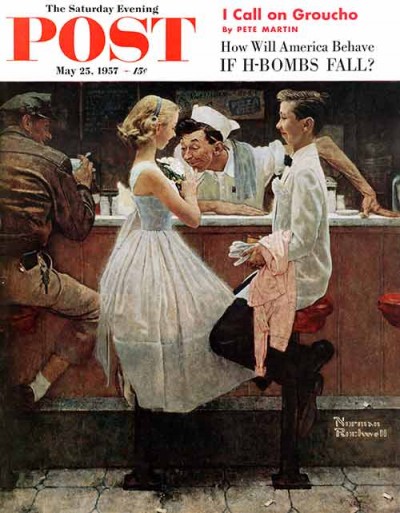
“After the Prom”
From May 25, 1957
It had to be only yesterday that this stylish young lady was a tomboy climbing trees and the dapper gentleman had a secret clubhouse dedicated to keeping girls out. But tonight she is a fairytale princess proudly showing off her corsage to a gracious footman, and he is an elegant prince. Alas, the corsage and tux rental have put a dent in the royal coffers, and the after-dance caviar and champagne will have to be burgers and soda at the local diner. But it doesn’t matter—they will remember it as if it were Buckingham Palace.
We’ve reviewed Rockwell’s art in the sixties and fifties, which of course leads us to the 1940s—next!